Lotus Belle Air Bud review: bringing instant-pitch elegance to the campsite
Exquisite inflatable polycotton tent for well-heeled glampers
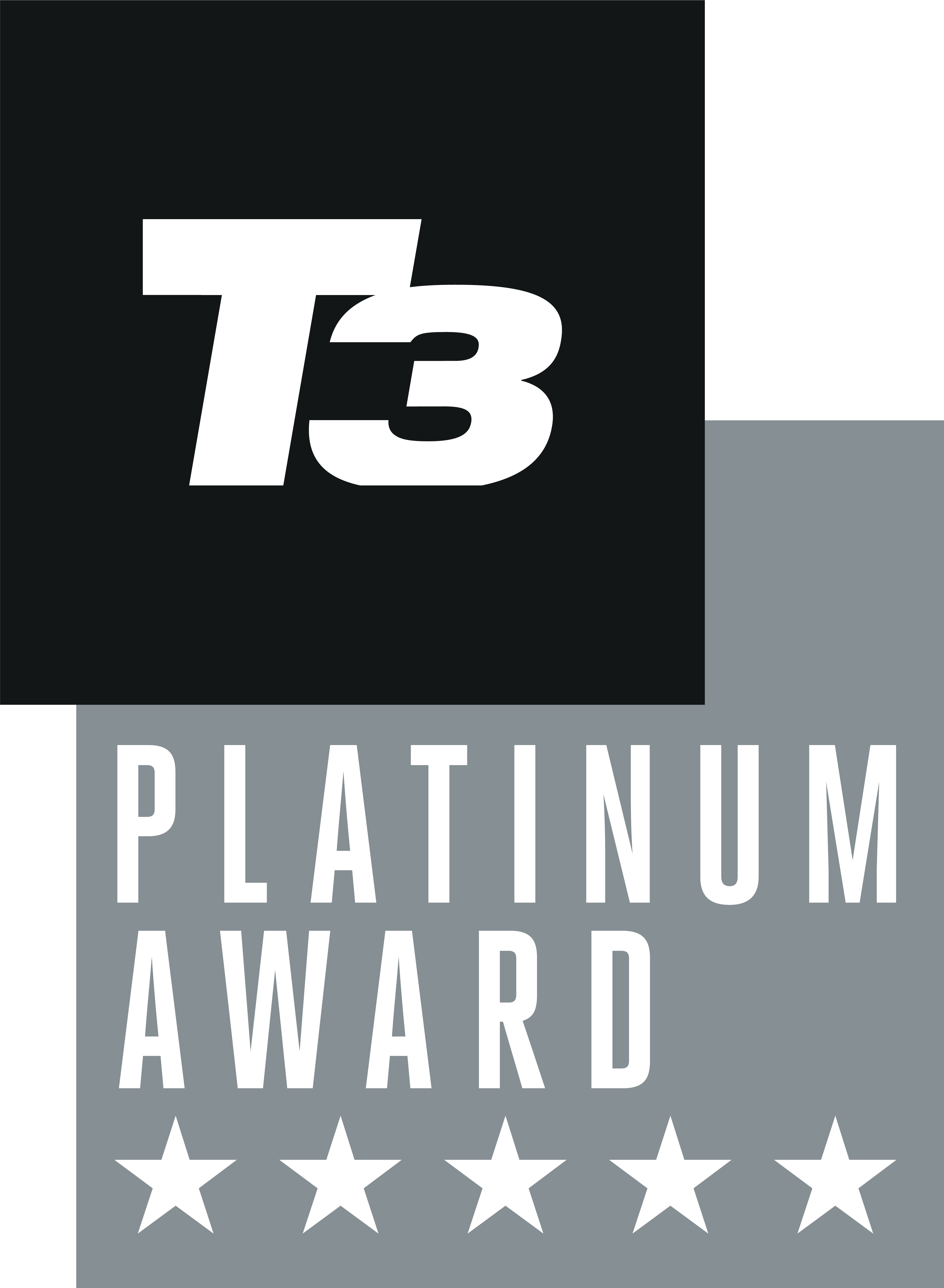
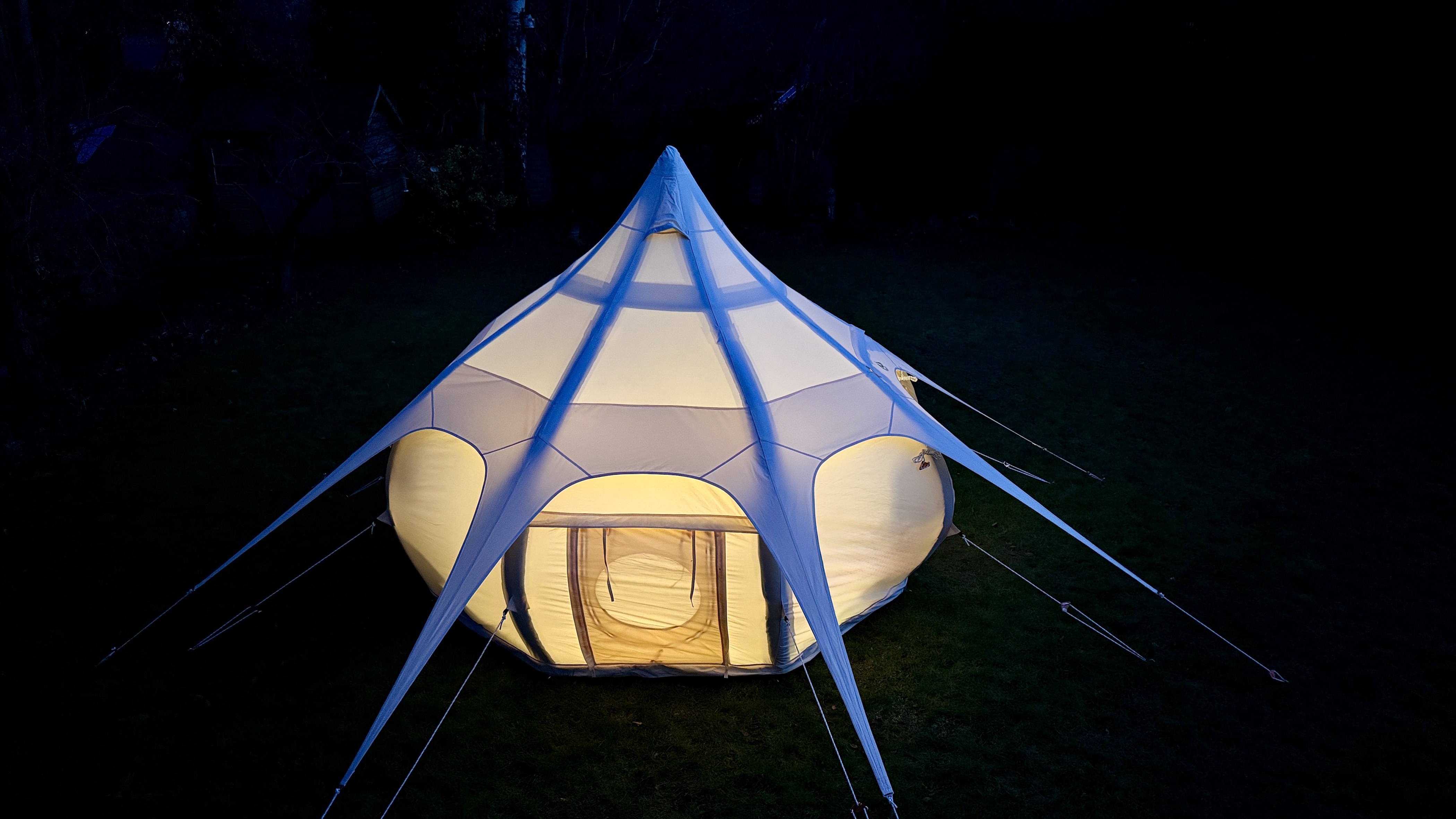
If you have the financial wherewithal and are looking for a premium two-person tent for your glamping adventures, the inflatable Lotus Belle Air Bud is a shoo-in. This exceedingly well-designed polycotton air tent not only looks glamorous in any setting, but its low condensation, stupendous rigidity and airy interior make it suitable for camping all year round. And for its size and weight, it pitches in thrice.
-
+
Elegant polycotton design
-
+
Yurt-like spaciousness
-
+
Excellent craftsmanship
-
+
Easy to pitch
-
-
Expensive
-
-
Heavy to carry
-
-
Needs some TLC
Why you can trust T3

Welcome to our review of the Lotus Belle Air Bud, an elegant inflatable bell-shaped polycotton tent that pitches in minutes while providing plenty of living space for two and a pair of pooches.
I’ve always been fascinated by those classic-looking Dutch canvas and polycotton tents you frequently see at French campsites, but have been put off from buying one because most of them involve a complex set of poles and an even larger support pole in the centre.
Well, I’m pleased to say that this British-designed entry into the world of high-class glamping doesn’t have any poles at all because it’s inflatable. If you want to learn more about polycotton tents and why they’re so desirable, head to the bottom of this review.
No question about it, this elegant and exceedingly well-made model most certainly warrants a spot in our best tents guide, but does its high price and extra weight justify biting the bullet and embracing the wonders of polycotton? There’s only one way to find out.
Lotus Belle Air Bud review
Price and availability
Lotus Belle tents are available direct from the UK manufacturer. If you live in the UK you can purchase the Air Bud direct from the Lotus Belle website for £960 plus shipping (approx. $1,190/ AU$1,896).
If visiting the Lotus Belle website from another country (including the USA and Australia), use their online contact form and make your enquiry about delivery costs to your country.
Pitching process

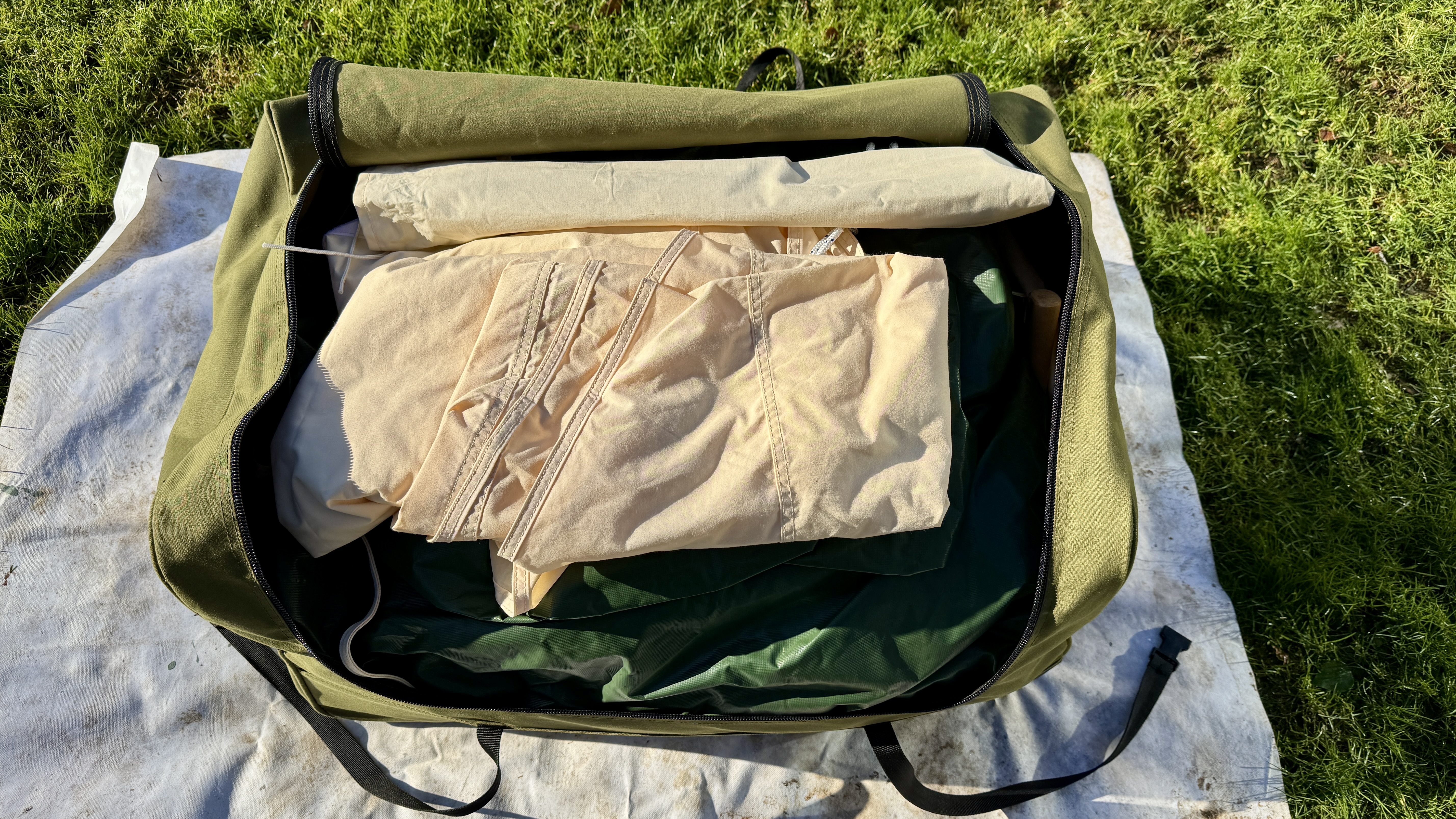

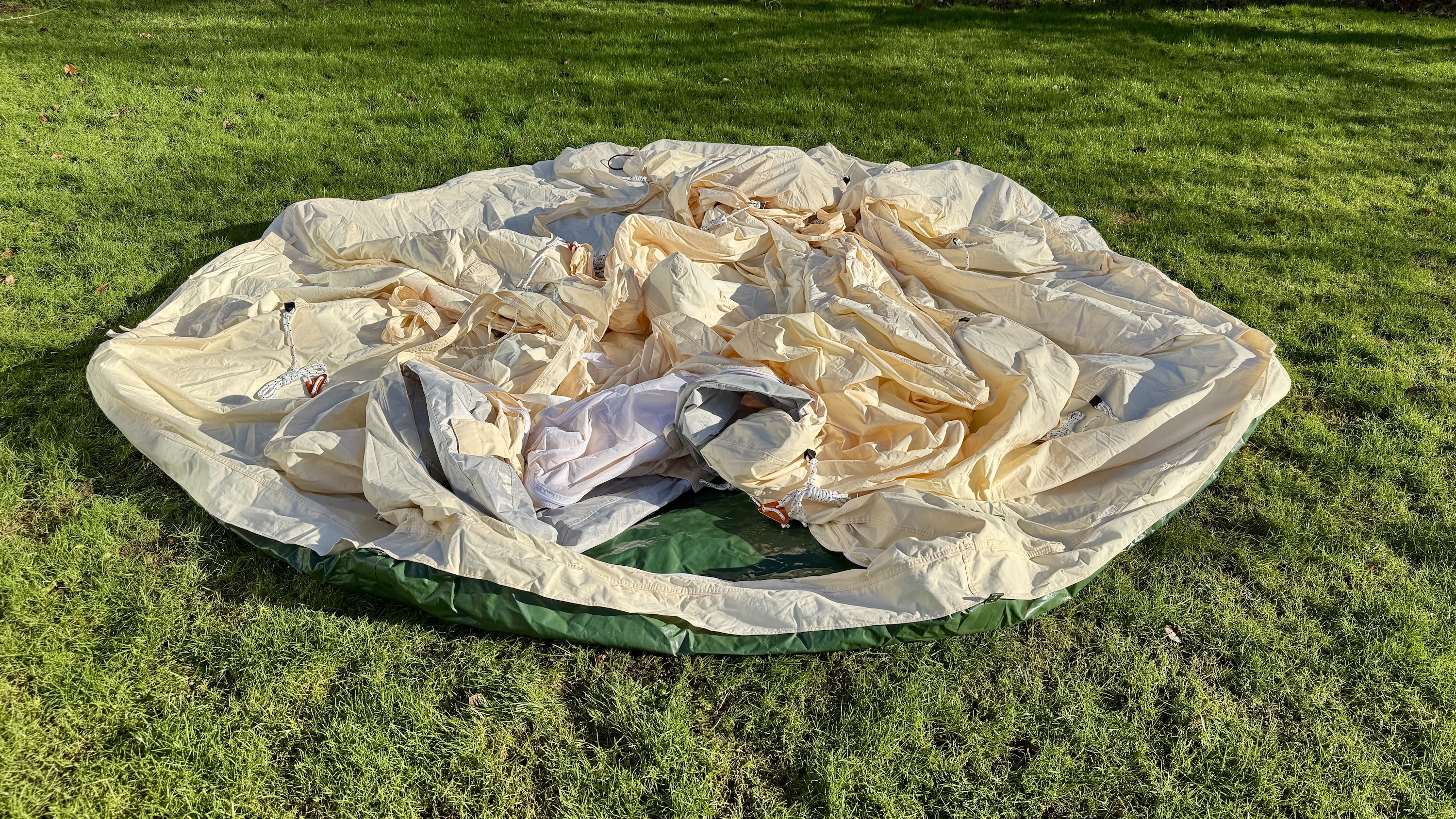

The Air Bud arrived in a well-made zipped canvas bag with a pair of casters on the rear for relatively easy portage from car to to pitch. Although this tent features an extra thick sewn-in ground sheet tub, I would advise pitching it on a large sheet of plastic or groundsheet material to prevent mud on the bottom of the main groundsheet from getting on the beautiful outer layer when folding it up to put away.
Against all expectations, it turns out that this tent was easy enough for me alone to erect. And it didn’t feel as heavy as I expected – the stated weight is 31kgs. Since it’s an air tent, there are no poles involved in its construction aside from one single support pole for the porch, which is included in the price. Erection is a simple process of laying it out like any air tent and pegging the groundsheet down using the supplied heavy-duty steel pegs.
Now reach for an air pump, attach it to one of two inflator points on either side of the doorway and starting pumping. I would advise purchasing a long shaft dual-action model for this task so you can pump it up with straight legs for better efficiency. A fit person should be able to pump it up in about five minutes but it took me at least 10 with rests in-between.
Since this model’s air tubes are all linked together as one large air space, you only need to use one inflator point. This is a marked difference from most synthetic air-beam tents that require up to three separate inflators. After about three minutes of pumping I wormed my way through the door and pushed up the centre section and, voila, the whole thing popped up to form its distinctive onion- or garlic-shaped profile.
I continued pumping until the tubes felt firm enough and then proceeded to embark on the time-consuming process of pegging all the heavy-duty nylon guy ropes down – and this tent comes with a staggering 24 in total. I’d say the entire process of pitching and fixing took me about 25 minutes, but then I wasn’t exactly rushing. Two people would have it up in half the time.
I should quickly add that it’s advisable to have the front entrance zipped up when pitching so the tent erects evenly without any creases in the fabric caused by one side pulling against the other. I made that mistake which is why some of the images here show some wrinkles.
Design and features
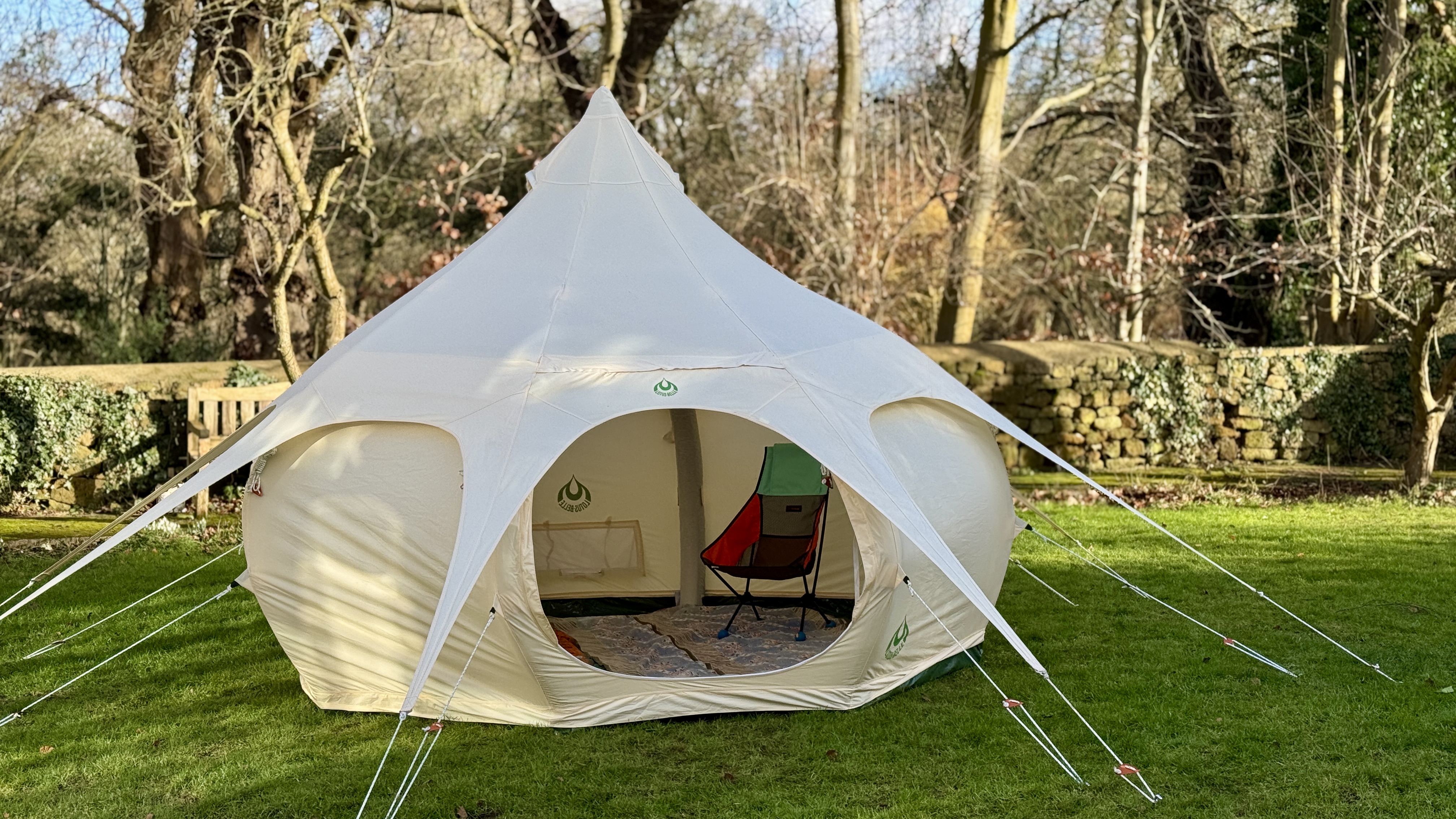
I’ll cut straight to the case… this is a fantastic tent by any stretch of the imagination. Build quality is exemplary, from the quality of the polycotton fabric and expert stitching to the ultra-thick sewn-in groundsheet tub. Everything just smacks of quality and excellence. And when fully pitched, it’s a picture of elegance that will definitely draw many admiring looks from passers by.
Although the Air Bud will accommodate three people, I think it’s absolutely ideal for two, perhaps with an accompanying pet. Unlike most tunnel-style tents, you don’t get any separate rooms here; like a yurt, it’s just one big open-plan space for you to kit out and style the way you want.

Since this is an air-beam tent, there are no annoying poles in the centre to prop up the peak. Instead, you get a striking array of air tubes that all link together as one. If you don’t like the look of all those beams while you’re lying in bed, you can always opt for Lotus Belle’s ingenious Cocoon Tent Lining (£160), with or without a floor. This will transform the interior ambience to a level of luxury that’s on par with a posh Serengeti safari lodge.
The Air Bud measures 3m across and an amazing 2.40m at its tallest point, directly under the peak. However, because its sides are so tall, I was able to walk around the inner perimeter without my head ever touching the material (I’m 5’6”). I’d say it’s easily one of the tallest tents I’ve ever been in and I can’t foresee any issues for even the tallest of campers. The Air Bud’s groundsheet deserves special mention because it’s probably the thickest I’ve ever seen – almost as thick as a pool liner – and I can’t imagine anything being able to puncture it.
As mentioned above, the Air Bud comes equipped with eight ground sheet fixtures and eight guy-rope segments, each one with three separate guy-line attachments. This amounts to an incredible 32 ground fixtures for utmost rigidity in pretty much all weathers. In fact, I’ve read stories of this tent surviving a storm where others have been ripped apart.
According to Lotus Belle, this tent’s flysheet sports a hydrostatic head of 1,500, which means it’s resistant to quite heavy rain, the sort we might experience here in the UK during the summer months. However, this model isn’t designed to be set up and left for weeks at a time. According to the manufacturer, the Air Bud is ‘designed with easy camping and festivals in mind and should not be pitched on a semi-permanent basis’.
For extra peace of mind, you might wish to invest in one of Lotus Belle’s polyester Tent Roof covers, which adds extra rain and UV protection.
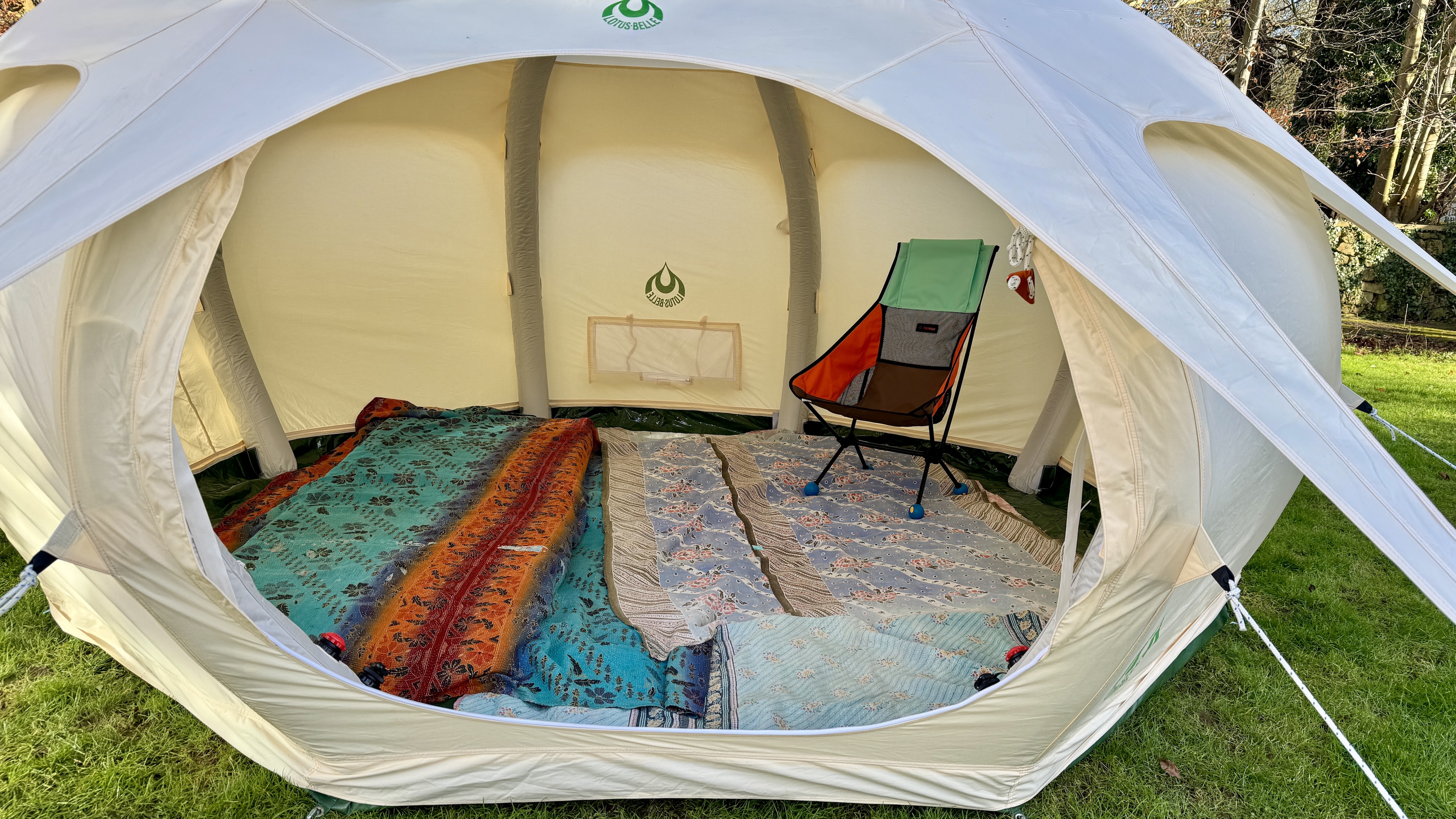
You'll have no trouble getting in and out of this giant portal
Let’s look at some of this tent’s finer details. Firstly, the Air Bud has a huge entrance that makes it very easy to get in and out of. The entrance door comprises a no-see-‘em inner mesh and polycotton outer like the rest of the tent. Inside it’s like being in a yurt and strangely comforting and calm, mostly because outside noise is less noticeable than being inside a synthetic tent, but also because it’s so wonderfully light and airy.
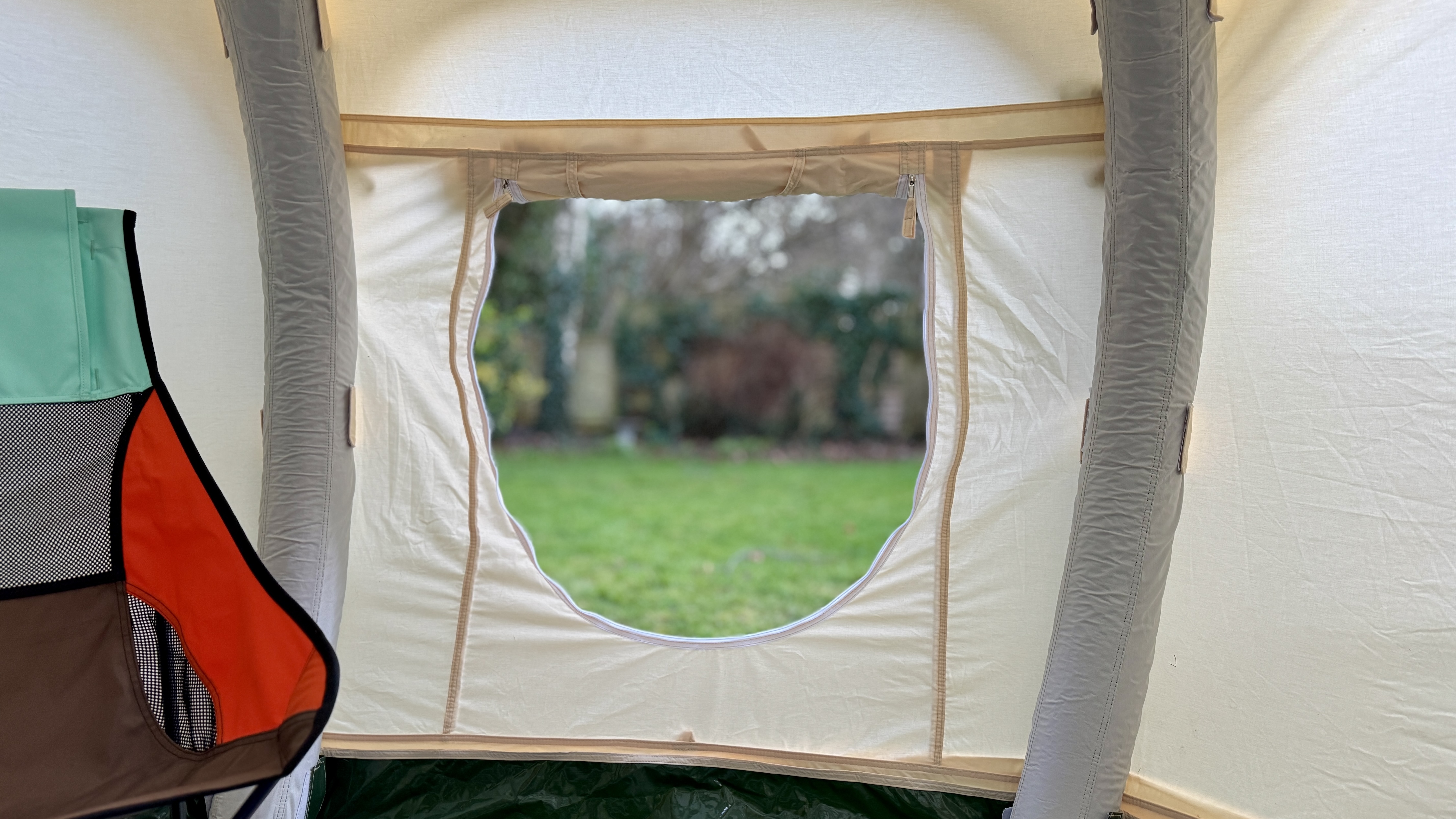
Like all polycotton tents, this model is single skinned because it breathes so well with negligible evidence of any condensation. That said, there is a ground-level air vent at the rear and another permanently open vent on the peak for added ventilation. There are also two side portholes large enough to crawl through. These not only allow air to move through the tent on the hottest days but also provide a window to the outside world. Both portholes have double flies comprising an outer skin and no-see-‘em mesh for privacy.
The only things missing inside this tent are some side pockets for storing torches, phones, reading matter etc. Who knows, perhaps the act of sewing in some internal pockets might compromise its waterproofness given that it’s singled skinned. While I’m at it, I’d also have liked to have seen a few strap connectors dangling from the air poles to hang up some indoor lighting.
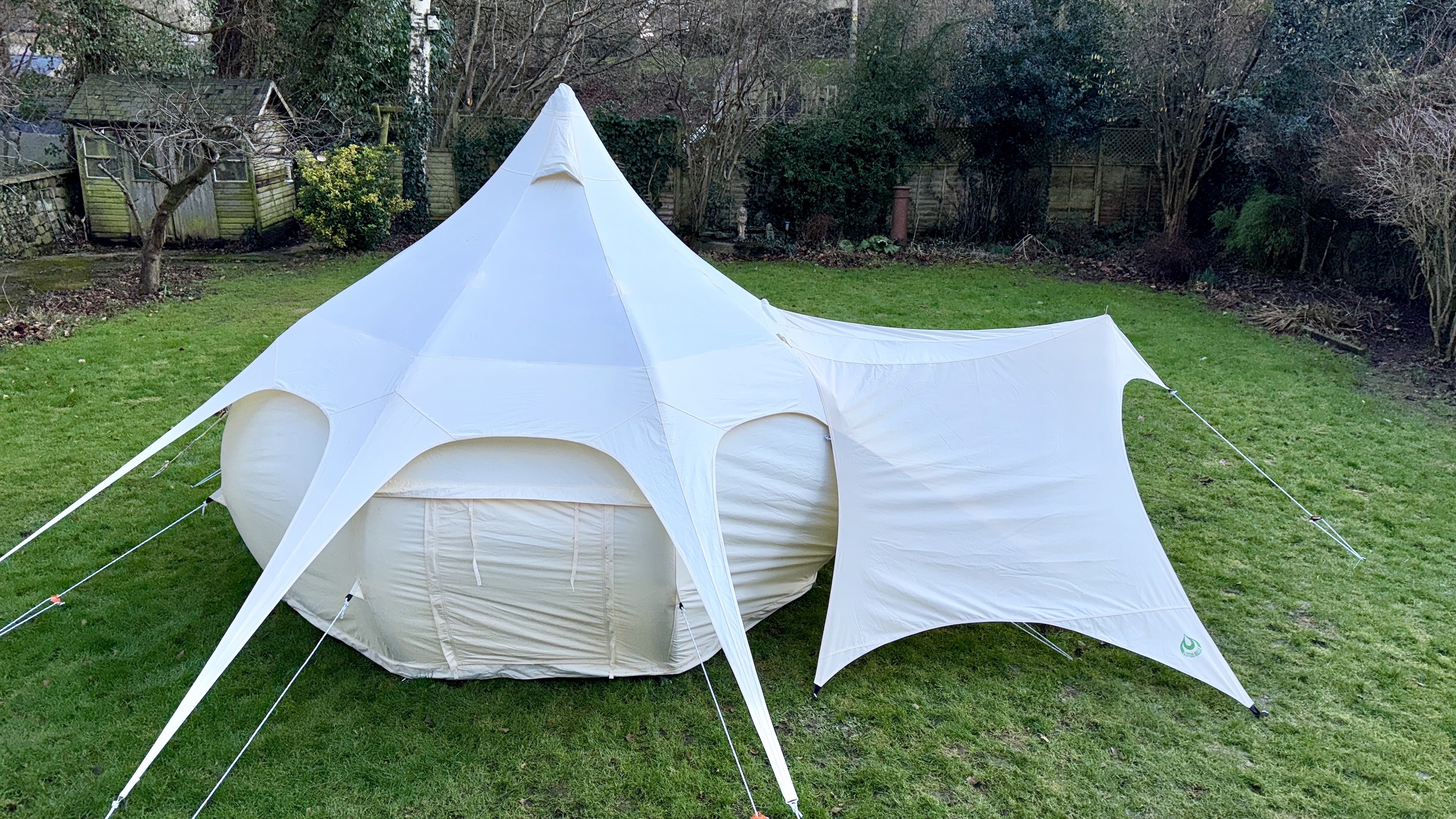
The Air Bud also ships with a front porch that's secured by two guys and supported by a single pole
Incidentally, Lotus Belle also includes an angular porch area for storing things and cooking in inclement weather. This porch is secured by two guy ropes and a single centrally-located pole for support. I’d personally have preferred a more igloo-shaped entrance area like some of Lotus Belle’s other tents, if only for better aesthetics.
The Lotus Belle Air Bud is available in four colours – off-white as reviewed here, plus red, blue and purple. For me off-white wins every time, mostly because it’s a traditional colour for polycotton tents and, besides, it just looks so much more elegant and stylish.
Incidentally, if this three-metre variant is too small for your needs, consider the even more expensive inflatable Air Belle model which stretches to a whopping 4.6m in width. Or take a look at some of Lotus Belle’s other pole-based models.
Performance and comfort

Since I tested this tent during an English winter with occasional icy-cold rain, I admit to having not slept overnight in it. However I had it up for three whole days and spent a lot of time in it, during both daylight and evening hours.
It’s difficult to explain just how lovely it is to spend time inside a polycotton tent like this. Don’t get me wrong, I adore the Quechua Air Seconds 5.2 Fresh & Black I reviewed last year but being inside this model makes you feel relaxed and calm, and without a care in the world. Not only does it look sophisticated and aesthetically pleasing from the outside (especially at night when it looks like a lit-up spaceship), but inside, it feels wonderfully airy and spacious.
Yes, you will need to adjust your sleeping arrangements to fit its circular shape and you may want to keep most of your camping clutter in the car so it doesn’t end up looking like a tip. But on the plus side, there’s space inside for two camping cots, a couple of camping chairs, a small table and a sleeping spot for the dog’s bed.
I set this tent up on a dry winter’s day which certainly made it easier. However, its one-piece design makes it perfectly possible to pitch in the rain. On day two, it started to rain, so I dived in and spent a few hours testing a new portable power station. I immediately noticed how much quieter this space is in the rain. Yes, you will still be able to hear the pitter patter, but the sound is more subdued and strangely pleasant.
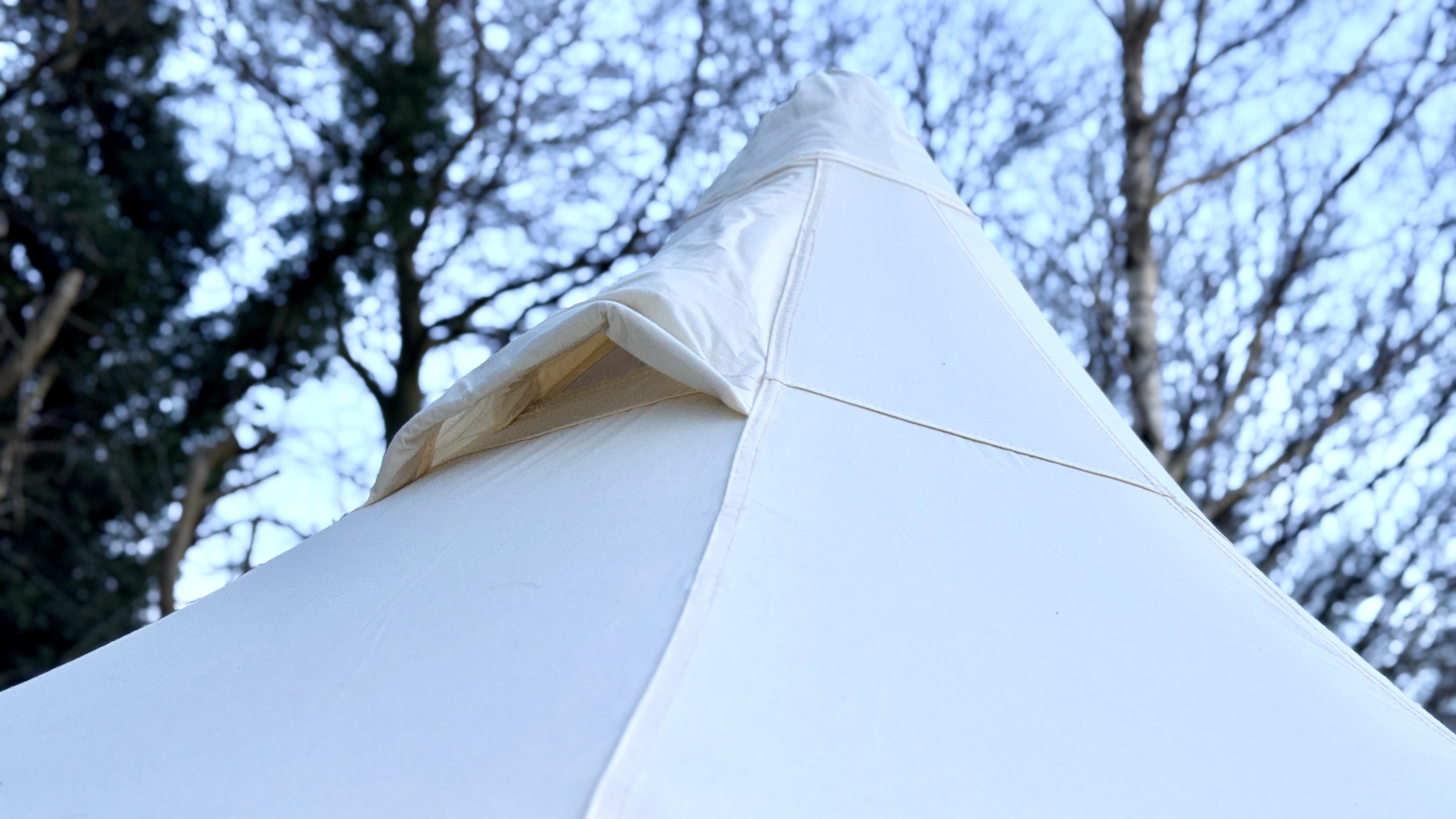
Polycotton is breathable so condensation is rarely an issue. Nevertheless, this model still has plenty of ventilation
I was mindful when taking the Air Bud down that it was still damp from rain the day before, and this is where polycotton can become a bit of an inconvenience since you would need to wait for the earliest dry day to let it dry in the sun. Even synthetic tents should be dried out before storing for long periods, or mould will set in and make the tent smell bloody awful the next time you use it. Polycotton is even worse because mould eventually causes the fabric to rot, and that’s the last thing you want, given the high price of the tent in the first place.
Do I think this model justifies it’s £960 asking price? If you’re just a couple, have the funds and are after something quite radically different from the norm, I would say absolutely go for it, because I guarantee that you will very quickly come to appreciate this model’s airiness, overall ambience and classic yurt-like styling. And besides, you could easily pay a similar sum for a premium 4-season 2-person backpacking tent that's a fraction of the size of this comparatively gargantuan model.
Verdict
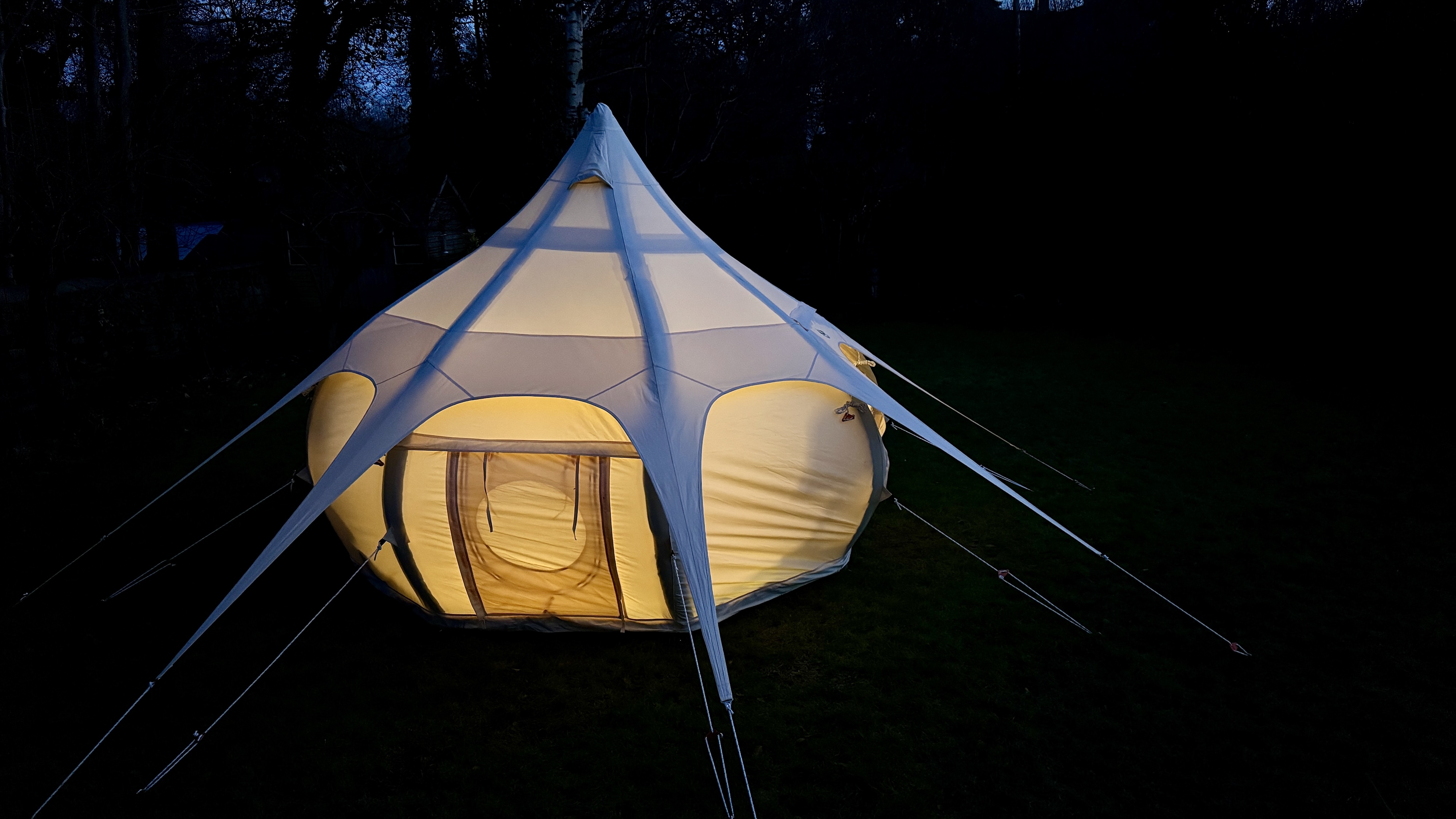
The Air Bud looks amazing at night when you've got some lights on
Granted, £960 is a lot of hard-earned to spend on a tent, especially one for two people and three at a pinch. Nevertheless, I still think the inflatable Air Bud is good value given the expertise of its design, the quality of its polycotton fabric, its ease of pitching and taking down, the immaculate stitching and all the other little design flourishes that you notice once you’ve spent some time in it. If looked after, this debonair home-from-home should last you for many years of happy glamping.
The pros and cons of polycotton tents
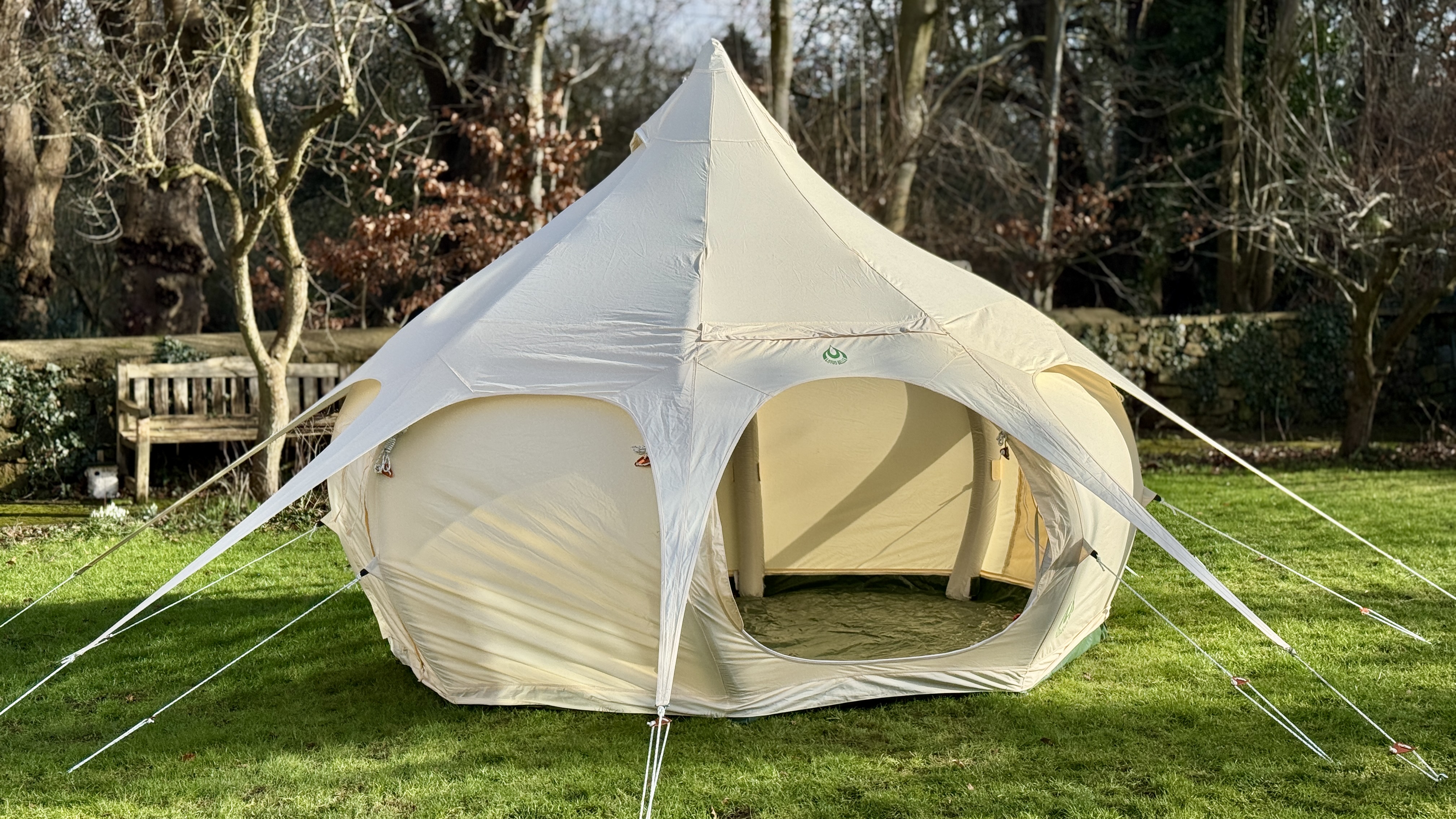
The vast majority of tents are made from a variety of coated synthetic rip-resistant composites, most notably polyester but also RipStop (a kite material) and nylon. They have served the camping industry extremely well for many decades.
However, while these materials are exceedingly light, incredibly strong and excel at repelling rain, they are also not very aesthetically pleasing to look at, and they also feel cheap and crinkly when you run the material through your fingers. Polyester tent materials are also paper thin, which means that they make an annoying ruffling sound in the wind, and when inside, you will hear every drop of rain.
Furthermore – and perhaps worst of all – synthetic polyester composites are not remotely breathable and very susceptible to condensation, which is why polyester-style tents are always double-skinned with an air gap of at least two inches between the inner section and the outer weather-resistant flysheet.
They are also equipped with a surfeit of air vents that help reduce condensation at the expense of making the tent feel cold inside during late summer and autumn when condensation is at its worst.
Advantages of polycotton
Aesthetics
Polycotton is on another level when it comes to finesse and style. This is because polycotton gives a tent a classic, high-quality canvas look, especially if its in a traditional off-white or desert tone. Other campers will not be able to pass by without shooting an admiring, perhaps envious, glance while you bask in the knowledge that you chose your tent very wisely.
Durability
Polycotton tents are exceptionally durable. The blend of natural environment-friendly cotton fibres with synthetic polyester enhances strength, reducing wear and tear over time. Also, unlike polyester or nylon which can degrade under UV exposure, polycotton maintains its integrity for years, which is why they are such a great choice for campers who want a tent that can withstand multiple seasons. If looked after, a polycotton tent will likely last a lot longer than a synthetic one.
Breathability
Another big advantage of polycotton is its breathability, which is why polycotton tents are almost always single skinned. Since cotton allows air to circulate, preventing condensation buildup inside the tent, it means you can enjoy a comfortable and dry interior, even in humid or cold conditions. Also, unlike synthetic materials, which often trap moisture and feel stuffy, polycotton tents provide a much more pleasant sleeping environment.
Temperature control
Polycotton excels at maintaining a comfortable internal temperature. In hot weather, the fabric allows heat to escape, keeping the interior cool. Conversely, in cold conditions, polycotton retains warmth better than thin synthetic fabrics. This adaptability makes polycotton tents suitable for year-round camping.
Water resistance
Although cotton is naturally absorbent, the polyester blend in polycotton improves its water resistance tenfold. Most polycotton tents undergo a weathering process by the manufacturer where exposure to water causes the fibres to swell and create a natural water barrier. With proper maintenance, a polycotton tent will withstand heavy rain while avoiding issues like condensation.
Reduced noise
Another key selling point is that polycotton, with its heavier-grade fabric, significantly reduces noise around you, especially the sound of rain. Additionally, it also weathers strong winds extremely well with nowhere near the level of flapping and rustling that you get with synthetic materials.
Disadvantages of polycotton
Cost
Let’s jump straight to one of its biggest drawbacks – cost. In short, polycotton tents are much more expensive to buy than their synthetic counterparts. Their blend of cotton and polyester, combined with their durability and high level of construction, contributes to a much higher price tag.
Weight and pack size
Another big downside to polycotton tents is their weight. Compared to synthetic alternatives like polyester and nylon, polycotton is significantly heavier when you compare like for like. This makes it a no-go for backpacking or situations where portability is essential. Also, since polycotton is a dense material, the folded package size is generally larger, too, which means you will need a decent amount of boot space in the car to transport it. And if you go for a family-sized option, you will most likely need to add an expensive car trailer to the shopping list.
Longer drying time
Unlike fully synthetic tents that dry very quickly, polycotton tents take a lot longer to dry when exposed to rain or moisture. This means that extra care is needed to dry the tent completely before storage. Failing to do so can lead to mould and eventually rot.
Maintenance
Polycotton tents require more maintenance than synthetic tents. They need to be occasionally treated for water resistance to ensure longevity. Additionally, they must be stored in a dry area to prevent moisture buildup and fabric degradation over time. Polycotton and canvas are also in danger of being nibbled by mice and rats, so it is best to store your tent in an area with no rodents around. Who knew?
Sign up to the T3 newsletter for smarter living straight to your inbox
Get all the latest news, reviews, deals and buying guides on gorgeous tech, home and active products from the T3 experts
Derek (aka Delbert, Delvis, Delphinium, Delboy etc) specialises in home and outdoor wares, from coffee machines, white appliances and vacs to drones, garden gear and BBQs. He has been writing for more years than anyone can remember, starting at the legendary Time Out magazine – the original, London version – on a typewriter! He now writes for T3 between playing drums with his bandmates in Red Box (redboxmusic).
You must confirm your public display name before commenting
Please logout and then login again, you will then be prompted to enter your display name.
-
 Warning: Ciele’s refreshed Elite Collection may cause excessive garment envy on race day
Warning: Ciele’s refreshed Elite Collection may cause excessive garment envy on race dayFlex on your run crew with Ciele’s latest drop
By Matt Kollat Published
-
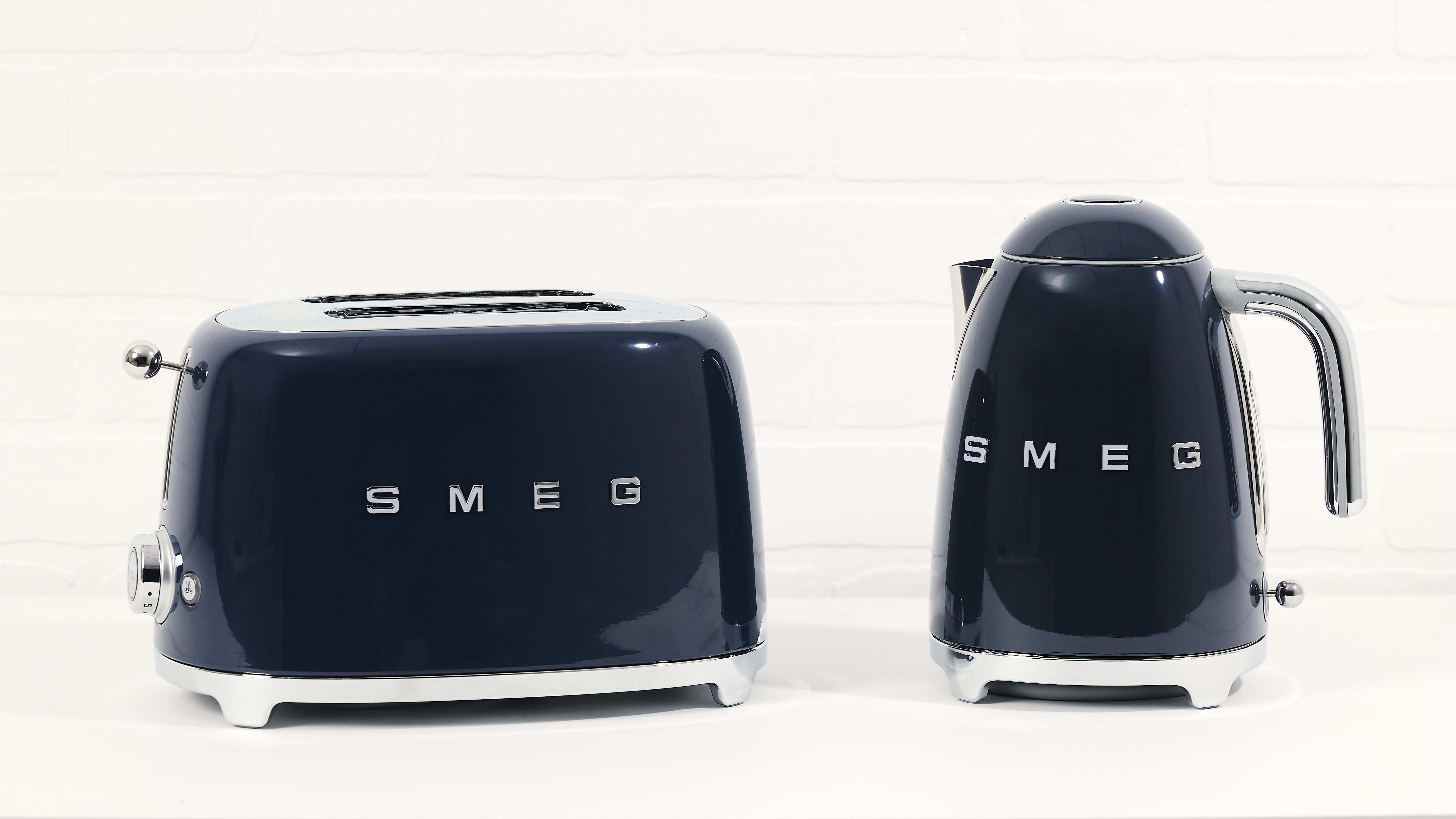 Smeg adds a touch of navy sophistication to its iconic breakfast set
Smeg adds a touch of navy sophistication to its iconic breakfast setIt's a minimalist's dream
By Lizzie Wilmot Published
-
 My most anticipated Netflix movie of the year gets a wild new trailer
My most anticipated Netflix movie of the year gets a wild new trailerHavoc looks pretty unbelievable
By Max Freeman-Mills Published